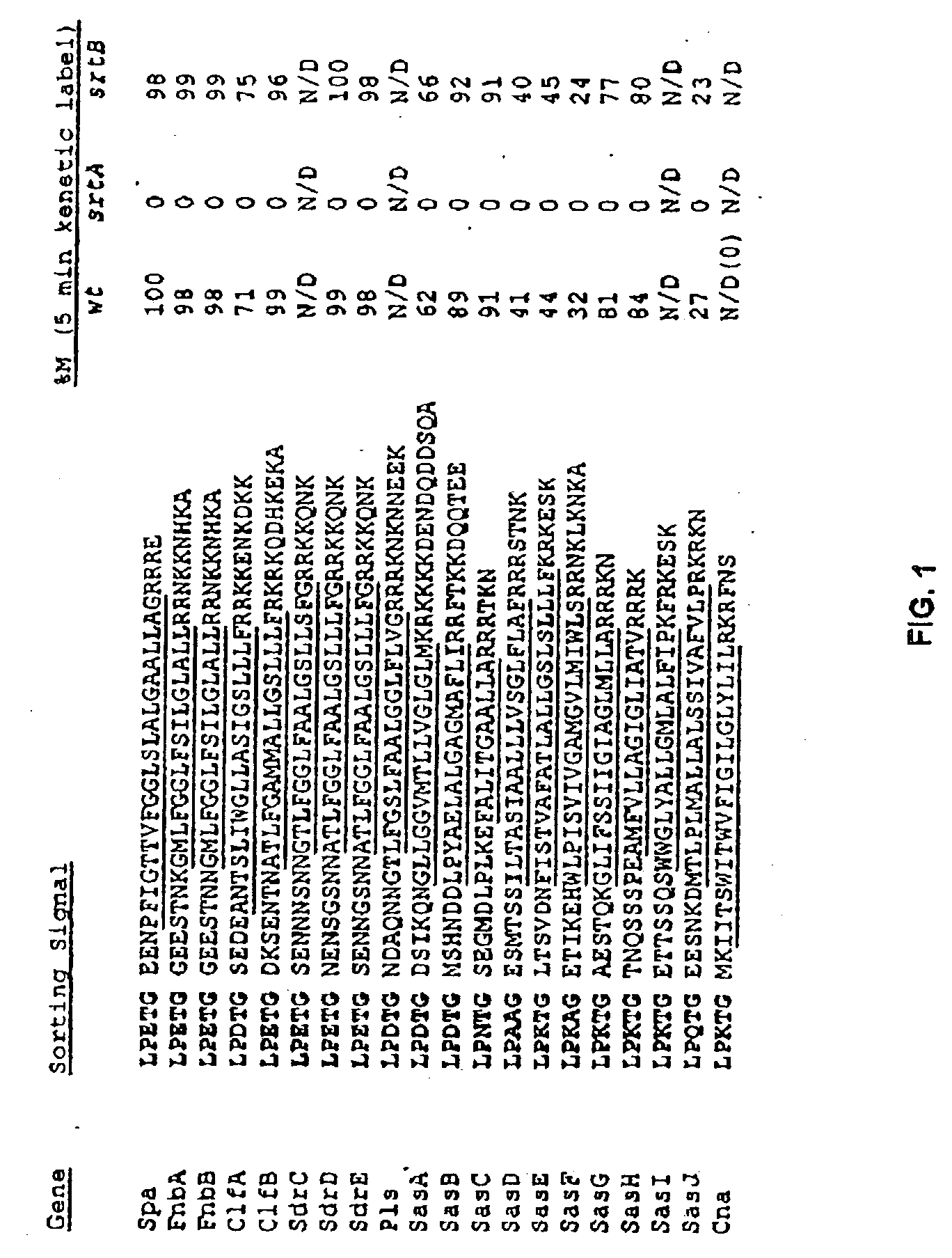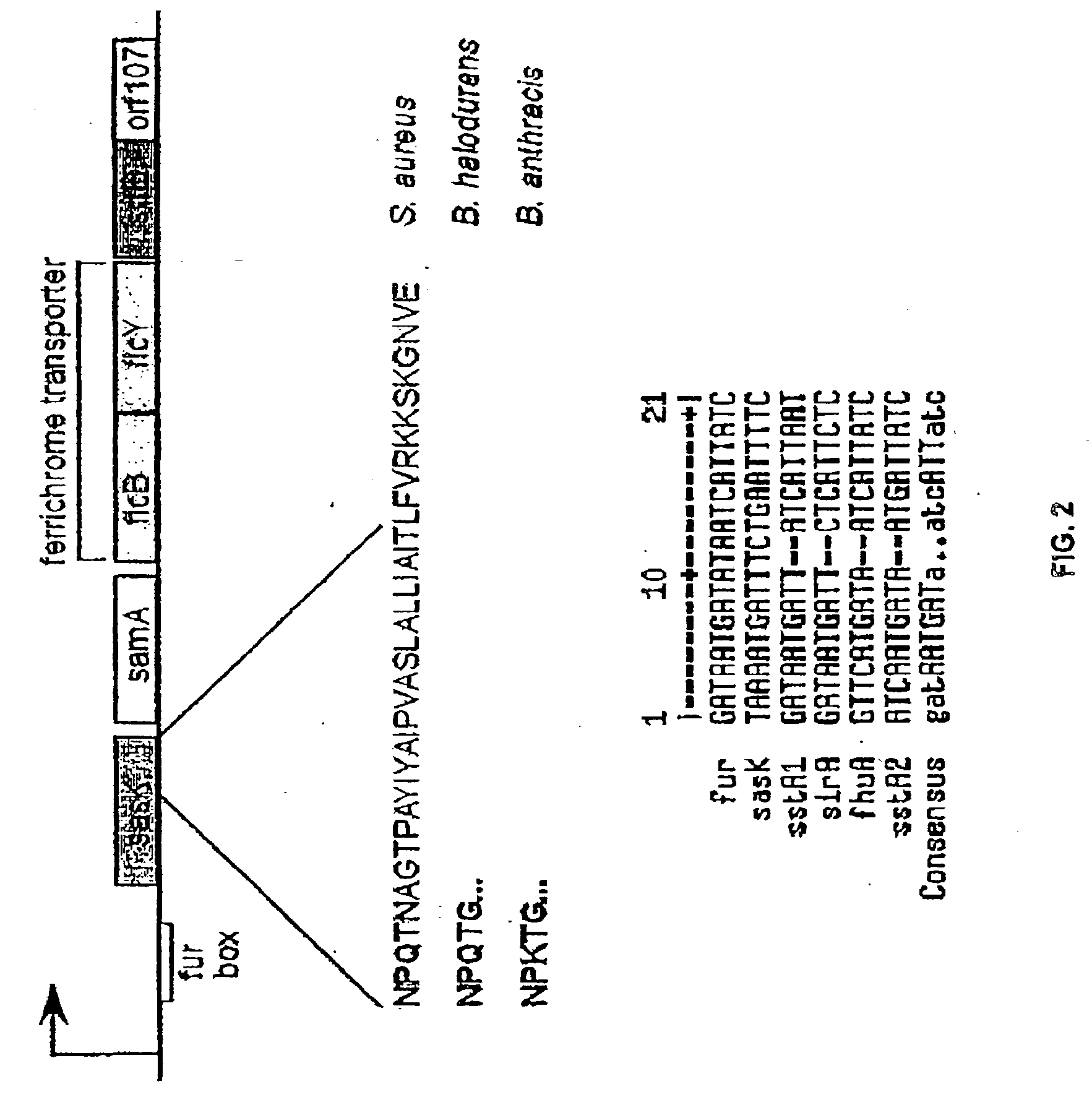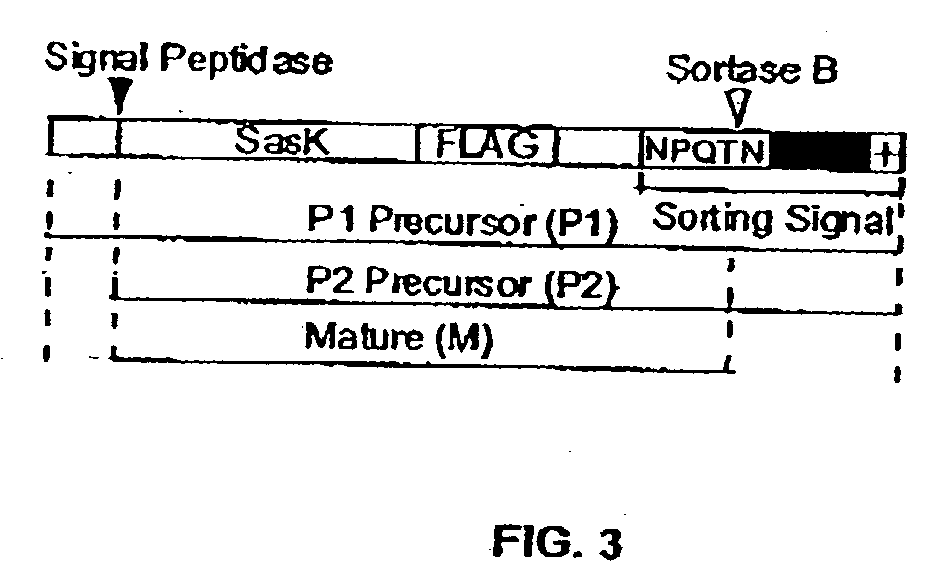Methods and compositions involving sortase B
a sortase and sortase technology, applied in the field of bacteria, can solve problems such as system failure and amputation, and achieve the effect of reducing the pathogenicity of the bacterium
- Summary
- Abstract
- Description
- Claims
- Application Information
AI Technical Summary
Benefits of technology
Problems solved by technology
Method used
Image
Examples
example 1
Identification of a Staphylococcal Mutant Defective in Cell Wall Sorting Generation of Temperature Sensitive (ts) Mutants Through Chemical Mutagenesis
[0368] Cell wall sorting mutants were created and isolated from a population of conditional lethal mutants of S. aureus strain OS2. Staphylococci were mutagenized with nitrosoguanidine and colonies were formed by plating at 30° C. Bacteria were streaked and incubated at 30° C. and 42° C. to identify mutants that are temperature sensitive for growth (ts). A collection of one thousand is mutants was transformed with pSEB-SPA490-524 (Schneewind et al., 1993), specifying a reporter protein for measurements of surface protein anchoring. The SEB-SPA490-524 precursor (P1) is exported from the cytoplasm and its NH2 terminal leader peptide removed to generate the P2 intermediate. The P2 precursor is the substrate for sortase, which cleaves the polypeptide between the threonine and the glycine of the LPXTG motif and generates mature, anchored s...
example 2
Inhibitors of Cell Wall Sorting
[0390] To study the effects of antibiotic cell wall synthesis inhibitors interfered with the anchoring of surface proteins, the activity of several inhibitors were examined in a Gram-pcsitive bacteria sorting assay. A search for chemical inhibitors of the sorting reaction identified methanethiosulfonates and p-hydroxymercuribenzoic acid. Thus, sortase, the enzyme proposed to cleave surface proteins at the LPXTG motif, appears to be a sulfhydryl containing enzyme that utilizes peptidoglycan precursors but not assembled cell wall as a substrate for the anchoring of surface protein.
[0391] In order to identify compounds that interfere with the anchoring of surface proteins a reporter protein Seb-Spa490-524 which, when expressed in S. aureus OS2 cells, is synthesized as a precursor in the cytoplasm and initiated into the secretory pathway by an NH2-terminal leader peptide (P1 precursor) was utilized (Schneewind et al., 1993). After signal peptide cleavage...
example 3
Purification and Characterization of Sortase-Transpeotidase
[0414] To examine whether staphylococcal sortase captures surface proteins after their cleavage at the LPXTG motif as acyl-enzyme intermediates, the proposed acylenzyme intermediates between surface protein and sortase were treated by hydroxylaminolysis (Lawrence et al., 1970; Kozarich et al., 1977). In this model, the sulfhydryl of sortase may function as a nucleophile at the peptide bonal between threonine and glycine, thereby forming a thioester with the carboxyl of threonine and releasing the amino of glycine. Lipmann first used hydroxylamine to demonstrate the existence of acyl-enzyme intermediates as this strong nucleophile attacks thioester to form hydroxamate with carboxyl, thereby regenerating enzyme sulfhydryl (Lipmann et al., 1945).
[0415] Hydroxylaminolysis of Surface Proteins
[0416] Hydroxylaminolysis of surface proteins was examined by pulse-labeling staphylococci with [35S]methionine in either the presence or...
PUM
| Property | Measurement | Unit |
|---|---|---|
| molecular weight | aaaaa | aaaaa |
| pH | aaaaa | aaaaa |
| pH | aaaaa | aaaaa |
Abstract
Description
Claims
Application Information
 Login to View More
Login to View More - R&D
- Intellectual Property
- Life Sciences
- Materials
- Tech Scout
- Unparalleled Data Quality
- Higher Quality Content
- 60% Fewer Hallucinations
Browse by: Latest US Patents, China's latest patents, Technical Efficacy Thesaurus, Application Domain, Technology Topic, Popular Technical Reports.
© 2025 PatSnap. All rights reserved.Legal|Privacy policy|Modern Slavery Act Transparency Statement|Sitemap|About US| Contact US: help@patsnap.com



